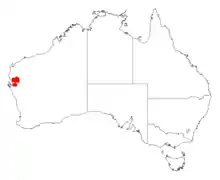Acacia anastema
Acacia anastema, commonly known as sandridge gidgee or just gidgee, is a tree in the family Fabaceae. Endemic to Western Australia, it occurs within a fairly small area of semi-arid land east of Carnarvon.
| Sandridge gidgee | |
|---|---|
| Scientific classification | |
| Kingdom: | Plantae |
| Clade: | Tracheophytes |
| Clade: | Angiosperms |
| Clade: | Eudicots |
| Clade: | Rosids |
| Order: | Fabales |
| Family: | Fabaceae |
| Clade: | Mimosoideae |
| Genus: | Acacia |
| Species: | A. anastema |
| Binomial name | |
| Acacia anastema | |
 | |
Sandridge Gidgee grows as an upright tree to seven metres high. Like most Acacia species, it has phyllodes rather than true leaves. These may be up to twenty centimetres long and five centimetres wide. The flowers are yellow, and held in cylindrical clusters between two and four centimetres long. The pods are slightly curved, up to 14 centimetres long and two to three centimetres wide.
Sandridge gidgee has limited utility. Its long straight limbs are resistant to termites, and so are locally used for fence posts. The tree provides no forage to animals as its canopy is typically out of reach of stock.
See also
References
| Wikispecies has information related to Acacia anastema. |
- "Acacia anastema". Flora of Australia Online. Department of the Environment and Heritage, Australian Government.
- "Acacia anastema". FloraBase. Western Australian Government Department of Parks and Wildlife.
- Mitchell, A. A.; Wilcox, D. G. (1994). Arid Shrubland Plants of Western Australia, Second and Enlarged Edition. University of Western Australia Press, Nedlands, Western Australia. ISBN 978-1-875560-22-6.